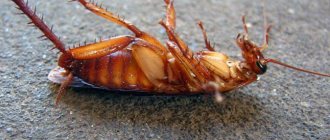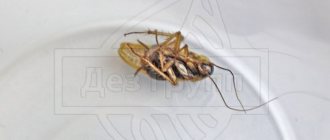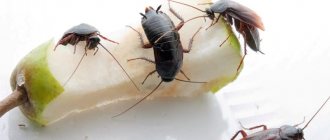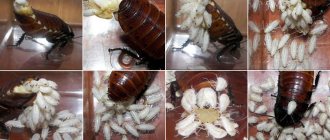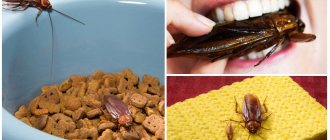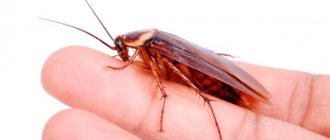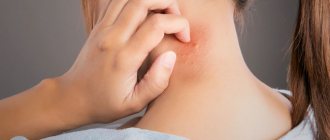This post has already been read 38658 times!
Greetings, dear readers. In today's article we will talk about the ability of cockroaches to bite people. The controversy surrounding this issue has not subsided as long as arthropods have lived next to humans. Some people believe that red-haired creatures do not bite; others are sure that at night they come out of their hiding places to profit from human skin. Who is right?
I will tell you whether cockroaches bite people, how, when and why they do it. You will learn what a cockroach bite looks like, what kind of trouble it can cause to a person, and also how to avoid these troubles if you do get bitten. At the same time, I’ll tell you how to protect yourself from arthropod cannibals if they do settle in your apartment.
Can pet cockroaches bite humans?
The behavior of cockroaches has its own specifics. The cockroach is capable of biting a person thanks to its powerful gnawing mouthparts. Fixation of the skin occurs between the powerful chitinous lips and horns of the insect's mandibles. A pair of upper jaws holds the skin, and the teeth pinch off the upper layers; when bitten, infection occurs with the contaminated oral apparatus and saliva of the pest. The basis of language with a specific structure is chitin. Well-developed organs allow cockroaches to absorb and digest any food, of any strength or coarseness. The insect can bite through cardboard paper, leather items, shoes, and denim items. Human skin is much more delicate than these things. It is not difficult for a cockroach to bite a sleeping person, especially considering that human skin has an odor that can attract the insect. They are active at night when the lights are off.
A red-pink crust with a diameter of up to 5 mm forms around the site of the cockroach bite. If characteristic signs of a bite are detected, you must immediately consult a doctor to prevent a possible inflammatory process. If a bite is detected, it is recommended to treat the wound with chlorhexidine or hydrogen peroxide.
Treatment of the affected area
If you have marks from an insect bite on your body, before deciding what to do about the bite, you need to find out which insect caused the skin damage. Bedbugs, as a rule, leave characteristic marks in the form of an itchy, intensely itchy stripe.
This effect from a bedbug bite is observed as a result of the influence of special substances in the saliva of bedbugs on the body cells. Prussians leave small open wounds in places where human skin is most delicate.
If you know for sure that a person has been bitten by a cockroach, and the wound does not heal within one day, you need to consult a dermatologist. The doctor will examine the bite site and prescribe treatment appropriate to the problem.
If there is a strong local reaction, allergy sufferers must take an antihistamine.
Sometimes you can’t get an appointment with a doctor. Then traditional medicine methods become relevant. Fresh plantain or raw potatoes, ground to a mushy state, will relieve inflammation. Tea compresses have a similar effect.
First aid after bites
Patients often delay visiting a medical facility for one reason or another. It is important to know what emergency measures need to be taken if a cockroach bite occurs.
First of all, the wound must be disinfected. Hydrogen peroxide, chlorhexidine solution, or another alcohol-containing product are ideal. And an antihistamine taken on time will relieve severe itching after an insect bite.
It is not recommended to apply brilliant green solution to the affected area. Otherwise, the development of purulent processes is likely.
Zelenka complicates further examination of the bite site in order to identify hyperemia and an inflammatory process.
Is it possible?
Cockroaches not only look menacing, they pose a threat to humans. Cases of attacks on humans by Prussians and other individual species of cockroaches are not uncommon. Prussians attack humans due to lack of food and drink. The shortage can be caused by active persecution, lack of direct access to water, an increase in the number of individuals living in the same premises, as well as violation of sanitary standards and regulations.
Currently reading: A unique domestic pest - the red cockroach
When biting a person, cockroaches do not want to harm him, but only want to save their life. They are driven by the instinct of self-preservation. If there is enough food and water, cockroaches will not bite people.
Cockroaches hunt exclusively at night. They can only bite a sleeping person. The pest is quite cautious and timid, and will not approach a person when he is awake.
Different types of cockroaches have their favorite places. Black cockroaches live in the kitchen, red ones can get into cracks and move from room to room.
What types of cockroaches are dangerous?
In Russia, only a few species of synanthropic cockroaches have become permanent inhabitants of houses:
Red or Prussian
The most common representative of synanthropic insects. Adults are small (9-13 mm), oval in shape, yellowish-brown in color. The pronotum is convex, the wings are developed. Thanks to their long limbs, insects are extremely mobile. The legs have a suction cup for moving along walls and ceilings. During the life cycle, the female lays 50-400 eggs. The larvae are dark brown, hardy, and able to penetrate the smallest crevices.
Insects infect food and home surfaces with infectious diseases, viruses, and helminth eggs. Feeling thirsty and hungry, they attack sleeping people and crawl into the ear canal.
Black
Widespread synanthropic species. Adults are large in size, males 20-25 mm, females 18-30 mm. The body color is black, the legs are reddish-brown. Short limbs cause insects to be slow. The wings are short and practically absent in females. Pests are omnivorous, contaminate food with feces, and carry pathogens on their paws. They are capable of fasting for a long period of time (up to 60 days), but without access to water they attack humans. A characteristic feature of the species is cannibalism.
American
Adults have an oblong, flattened body of a red-brown color. In terms of prevalence, they are inferior to Prussians, but are larger in size - males 28-44 mm, females 25-35 mm. The wings are developed, insects jump and fly well. Life expectancy is high - 1.5-3 years.
Egyptian
In the southern regions - Crimea and Transcaucasia - the Egyptian cockroach is found. Insects have a flat oval body and a shield-shaped pronotum. Females are wingless, almost black, and resemble turtles. Body size 40-45 mm. Males are smaller (20-25 mm), brown, and have wings. During reproduction, 12-18 eggs are laid in a special capsule. The distribution is uneven and depends on comfortable conditions. The species is thermophilic, prefers temperatures of 25-30°. Pests are mechanical carriers of diseases; when they nibble on the epidermis, they cause erosion and dermatitis.
How do cockroaches bite?
Fleas and bedbugs, after biting a person, leave a bloody spot around which the skin is inflamed.
Cockroaches do not bite, but gnaw human skin and leave behind wounds with slightly torn edges. The affected area of skin looks like a scar after a boil or pimple. Cockroaches are capable of biting through human skin in several places at the same time. Insect tissues, harmful dust particles and pathogens present on the pest's mouthparts, when entering the wound during a bite, can cause infection and an allergic reaction. During and after the bite, the person feels discomfort and a slight tingling sensation.
When examined under a microscope, a deep, crusted bite can be seen. There are bruises and fragments of dried lymph inside the wound. Cockroach bites are painful; itching after the bite indicates infection of the wound.
Regeneration after a cockroach bite is a rather lengthy process, since the upper layer of the epidermis is affected. To quickly restore the integrity of the skin, it is necessary to treat the wound with an antiseptic solution.
What does a cockroach bite look like in the photo?
The bite of a cockroach is significantly different from the bite of other insects. Visualization allows you to see the absence of part of the epidermis, as well as the depth of the wound, which is covered with a hard crust with a diameter of up to 5 mm. In people with sensitive skin, the crust can reach large sizes. Sometimes it can be indistinguishable from allergies.
Reasons for attacking a person
The reasons why cockroaches attack people are starvation, lack of access to water and an increase in the pest population. Cockroaches can live no longer than 2 days without water. Not receiving the moisture it needs through water, juice, fruits or vegetables, the insect strives for human skin. He looks for the food and water he needs, extracting them from the corners of a person’s mouth or eyes, as well as other parts of the body.
The cause of a cockroach attack on a person can also be a food shortage caused by a large number of insects in a given room, when not everyone has enough food and water.
Harm from poisoned parasites
Even poisoned insects pose a certain danger - after disinfestation has been carried out in a residential area using pesticides. Such specimens can harm pets: cats, dogs, birds. They playfully catch them and eat them, which leads to severe intoxication.
Most progressive insecticides have a prolonged spectrum of action, so they do not kill longhorned beetles instantly. For some time they still move, although slowed down. So the still living cockroach holds a poisonous bomb within itself.
Cats are more sensitive to insecticides, especially pyrethroids. The first symptom of poisoning will be the appearance of drooling. The animal behaves inappropriately.
Therefore, during sanitization and for the next 1-2 days, it is recommended to remove not only people, but also animals from the living space. Bullying can also have a negative impact on the person doing the pest control. To prevent such an outcome, thoroughly study the instructions for using the insecticide and follow safety precautions. Wear a respirator when working.| Read about effective cockroach repellents...
In reality, few people are careful, so cases of poisoning do occur. Often everything is limited to a slight malaise: dizziness, nausea, migraine.
What to do with bites, first aid
The secretion of cockroaches contains a special protein, which, when bitten, enters the human body and can cause a severe allergic reaction. Allergies can manifest themselves in different ways, depending on the strength of a person’s immunity to the protein. In the first days, allergies may look like hives, but then lead to asthmatic attacks.
Currently reading: Why cockroaches are called stasiks - versions and facts
An insect bite can also cause:
- Numerous inflammatory foci at the site of skin damage. Crusts form on the surface of the inflammation, and as a result, scars. A bite can trigger the development of dermatitis, accompanied by redness and irritation. Such consequences are caused by the bites of red cockroaches that live at home and bite a person in his sleep.
- The development of serious diseases such as dysentery, tuberculosis. Red cockroaches are carriers of bacteria of these pathologies.
- The occurrence of erosion, papules, blisters. Such consequences appear after the bite of American and Egyptian cockroaches. The bites of these pests are painful; purulent crusts often form after the bite. If the victim has a weakened immune system, the bite sites take a long time to heal, turning into ulcers.
A cockroach bite requires quick and immediate treatment. The treatment is carried out by a dermatologist.
If cockroach bites are detected, first aid must be provided immediately. It is necessary to treat the wound with an antiseptic to prevent infection. To soften the skin and relieve irritation, it is recommended to apply an ointment or moisturizer.
If the victim is prone to allergies, he should be given any antihistamine.
Favorite bite spots
Cockroaches can bite any part of the body, but they especially often bite the hands and face. Since the pest’s task is to find water and leftover food, those parts of the body that come into contact with food fall into the risk zone.
More often than other areas, cockroaches bite the area of the fingers, around the nail, the corners of the mouth, the area of the cheeks and lower jaw, and lips.
Wounds on the lips take quite a long time to heal; constant contact with food irritates the wound and creates conditions that inhibit the regeneration process. Food debris often contributes to the development of infectious processes in the tissues of the lips.
Cockroaches often target infants due to the abundance of formula or breast milk in the baby's mouth area. The child reacts to unpleasant sensations by crying loudly. A cockroach bite is especially dangerous for newborns, since their immune system is not fully developed and the likelihood of developing an allergic reaction is high. To prevent cockroach attacks on children, it is necessary to carry out hygiene procedures in a timely manner.
How to treat?
If a cockroach bite is detected, it is necessary to treat the wound with chlorhexidine, hydrogen peroxide (3%) or medical alcohol.
When the inflammatory process is fixed, cockroach bites should be treated with the use of anti-inflammatory drugs, in particular Fenistil, Akriderm, Levomekol. If allergies occur, antihistamines must be used.
It is not allowed to cauterize the wound with iodine or brilliant green; this will make it difficult to visualize the damaged area of skin, and suppuration may develop under the resulting crust.
What is the danger from a bite?
The danger of bites lies in the possible penetration of a serious infection. An inflammatory process often develops under the dried crust. The presence of an inflammatory focus is indicated by hyperemic skin around the wound, as well as the presence of swelling.
The lack of adequate treatment leads to the development of a purulent-inflammatory course. The victim's temperature rises; when feeling the wound, the patient feels pain, as well as constant pulsation.
Currently reading: Photo of an American cockroach in an apartment: how to remove it, how it bites, can it fly?
Cockroaches are carriers of various parasitic, fungal and intestinal infections. The latter can develop as a result of eating foods with the excrement of the pest.
Rarely, but there is a possibility of a dangerous disease – myiasis. The disease consists of the penetration of a cockroach larva into the thickness of the skin and its further development. Myiasis is treated surgically by desiccation of the larva with healthy tissue structures and applying an antiseptic bandage.
Often a bite wound becomes infected as a result of scratching or the presence of pathogenic organisms on the cockroach's legs. Cockroach saliva contains toxic components that can cause a severe allergic reaction.
How cockroaches can infect humans. How to get rid of cockroaches in an apartment forever
How to get rid of cockroaches in an apartment once and for all before they infect you with a dangerous disease? After all, this is not a joke and cockroaches, in addition to their unpleasant appearance, cause serious harm and pose a threat to human health. Let’s try to understand in detail what kind of harm and why cockroaches are dangerous to humans in this article.
Cockroaches are synonymous with dirt and poor hygiene in an apartment or house . Due to their indiscriminate choice of food, cockroaches are literally omnivorous and feed on everything, including rotten meat and rot, so these insects can easily pick up and carry a number of pathogens on their bodies or swallow them during their meal.
The red cockroach, or black cockroach , in particular, is the most common pest and appears anywhere food is served and food is processed - in homes, restaurants, cafeterias, food warehouses, commercial kitchens and hospitals.
For organizations and enterprises working with food products, for example, restaurants, cafes, canteens, manufacturers of semi-finished products , cockroaches are a gross violation of sanitary regulations and food safety standards, which is a clear sign of poor food hygiene and can lead to large fines up to termination of activity. The law obliges to enter into an agreement with the SES for deratization and disinfestation .
Cockroaches feed on anything suitable for human consumption, as well as many other natural foods such as cardboard, leather, feces and even the toenails of sleeping people .
Diseases from cockroaches
Cockroaches do not transmit diseases to humans through bites , like mosquitoes, bedbugs or fleas, but do this indirectly, eating leftover food from you, spoiled food in the trash container, from where they then bring pathogens, spreading them over all surfaces, dishes and products.
According to the World Health Organization (WHO): “Cockroaches are one of the most significant pests found in apartments, homes, food processing plants, hospitals and healthcare facilities worldwide.”
More than 60 pathogenic bacteria, fungi, mold, parasitic worms and viruses were found in the body of cockroaches , including: Salmonella, Campylobacter, Listeria, Escherichia coli, Staphylococcus aureus, Fecal Staphylococcus, Giardia, Shigella dysentery and others that can lead to such diseases, such as: hepatitis, lichen, leprosy, tetanus, tuberculosis, dysentery, gastroenteritis, salmonellosis, meningitis, mycobacteriosis, pneumonia and many others.
Many Salmonella samples collected in one study reported by WHO were resistant to antibacterial drugs, making infection control much more difficult if a person becomes infected.
Cockroaches can cause asthma
Cockroach allergy was first documented in 1943. The discovery occurred when patients began to become covered in the raw material after cockroaches in a hospital room crawled on their skin.
Cockroaches cause asthma because certain proteins in their feces and body parts can trigger an allergic reaction in some people. Tiny particles of dried feces and body flakes can become airborne with dust and become a potent allergen for susceptible people.
The American College of Allergy, Asthma & Immunology reports that the saliva, feces and shed body parts of cockroaches can cause both asthma and other allergic reactions.
Many studies around the world have found high levels of exposure to cockroach allergens in people living in urban areas, indicating the extent of cockroach infestations in people's homes:
- About 40% of houses in Russia contain cockroach allergens, and in urban areas their share has increased to 72-95%;
- In the United States, 60–80% of urban children with asthma have been exposed to cockroach allergens;
- In Poland, about 25% of children with asthma were open to it;
- In Taiwan, 58% of all people with asthma had it;
- In China, 11-98% of dust samples from nine cities contained cockroach allergens.
How do cockroaches spread disease?
Because these insect pests are true reservoirs for organisms that can cause disease rather than vectors, cockroaches use other means to spread disease.
Cockroaches spread dangerous diseases through:
- Feces;
- Saliva and vomiting;
- Direct physical contact with food and surfaces.
Cockroach feces
Due to their unsanitary eating habits, cockroaches can transmit harmful pathogens through their droppings. When a cockroach eats something contaminated, such as fresh animal or human feces, all the microorganisms present on it will enter the cockroach and can lie dormant or multiply in its digestive system. Then this pathogen will be released along with the excrement of cockroaches and will contaminate all those surfaces and products where they crawl.
Cockroach saliva and vomit
The cockroach's saliva and vomit are also responsible for the spread of microorganisms. Cockroaches sometimes salivate on their food before swallowing it, and they also periodically regurgitate partially digested food. Both can spread pathogens acquired from eating first contaminated food and then food or prepared food consumed by humans.
Direct contact
Cockroaches can be found in many dirty environments, which provide them with food, shelter and a suitable environment for survival. These include sewers, cesspools, drains and rubbish bins , where they come into direct contact with a range of microorganisms such as bacteria, viruses and fungi. All this pathogenic “good” sticks to the bodies of cockroaches and is carried to new places.
The feet of a cockroach, for example, have spines that are sensitive to touch and provide a very large surface area to crawl over any material and pick up pathogens. Anything a cockroach touches can be considered potentially infected.
How can you catch a disease from a cockroach?
You can get infected from a cockroach in different ways. However, it most often occurs when eating food contaminated by cockroaches or coming into contact with surfaces on which contaminated cockroaches have crawled, such as dishes.
If there are cockroaches in the apartment, you should be especially careful to ensure that they do not have access to your products and do not leave cooked food on the table for a long time.
Eating and eating contaminated food
The most common form of disease transmission from cockroaches to humans is through food and drink that the infected insect has come into contact with. This can be either through eating or drinking food or drinks that have been contaminated by cockroaches directly, or by eating or drinking something that has been prepared or served in contaminated dishes and cutlery that have been touched by contaminated insects.
Inhalation of polluted air
If the air supply is contaminated with dust containing particles of cockroach feces, dried saliva, vomit or insect scales, and this is inhaled by people with asthma, then the allergens can trigger an asthma attack .
Touching contaminated objects
Contact with objects that remained on the surface from dirty cockroaches that ran through here earlier is also one of the ways of transmitting diseases to humans. Contact with contaminated objects, for example, cockroaches running on a mobile phone, tablet, laptop left in the kitchen , and then touching the eyes, nose, mouth or open wound can lead to the pathogen entering the body and causing an infection.
How to prevent cockroaches from spreading disease
The best way to prevent the spread of disease from cockroaches in an apartment, home or business is to carefully maintain hygiene, keep it clean and tidy, and prevent these insects from appearing on your property.
You should remember the simple rules, thanks to which cockroaches simply will not want to live in your apartment:
- do not store food on the table, do not litter with crumbs, do not spill drinks, clean up after eating, wash dishes and take out the garbage in a timely manner before it rots;
- do not allow water leaks in the kitchen, bathroom, toilet;
- seal all the cracks and cracks in the kitchen, toilet and bathroom so that cockroaches do not come from neighbors through pipes and cracks;
- If insects are detected, immediately take measures to combat cockroaches .
What to do if cockroaches appear in your apartment? Fighting cockroaches
When cockroaches appear in an apartment, you should first of all not hope that they will also disappear on their own; most likely, they appeared for a reason - this means that in your apartment there are favorable conditions for their settlement and reproduction, so you should clean and find out if then eliminate the cause of their appearance.
Unfortunately, in many cases, people do not pay due attention to the problem of the presence of pests in the apartment for a long time and there are so many insects that disinfection from cockroaches .
Destruction of cockroaches. How to get rid of cockroaches in an apartment forever
The destruction of cockroaches in St. Petersburg in an apartment is a very popular service, since there are really a lot of cockroaches and they are taking over apartments and entire apartment buildings in the city center and residential areas.
To get rid of cockroaches in an apartment forever , you need to order professional treatment from professionals from the city’s specialized SES service and remove the pests using treatment . The most effective is baiting cockroaches with cold fog , in which the insects do not have a single chance of survival.
Complete 100% destruction of cockroaches . After disinfection against cockroaches, you will receive this contract, confirming the treatment performed and establishing the terms of the guarantee. Trust the fight against parasites to professional disinfectors with extensive experience and certified products.
Myths about cockroach bites
There are widespread opinions about cockroaches that are often untrue.
First myth
Many believe that since cockroaches are not harmed by the radiation they accumulate within themselves, their bites can cause mutations.
The truth is that these whiskered pests can withstand 15 times the amount of radiation allowed for humans. But accumulation and mutation as a result of a bite are a fantasy.
Second myth
It is believed that cockroaches love to eat earwax, nails and human hair.
In fact, cockroaches are omnivores and can bite a sleeping person anywhere. They can crawl into a person's ears, creating a serious danger to health and life.
The third myth
It is often said that a cockroach bite can cause anaphylactic shock.
The appearance of such a pathological condition is possible in rare cases. Most often, a person who has been bitten by a cockroach experiences an allergic reaction, which manifests itself in the form of itching, watery eyes and shortness of breath.
Can a cockroach crawl into your ear?
The news that cockroaches end up in people's ears will be perplexing for some, and a skeptical smile for others. But for those who experienced first-hand what a cockroach in the ear is, believe me, it was no laughing matter.
The online version of the British publication The Guardian published the story of a man named Hendrik Helmer, who one night felt signs of a cockroach in his ear, and as a result experienced a real nightmare. He tells:
“I woke up at 2 a.m. and realized I couldn’t hear in one ear. In my sleep I was still not thinking clearly, but I realized that there was something inside. It was difficult to understand what it was, my finger didn’t go deep enough to feel, but I felt that my ear seemed to be swollen from the inside. It later turned out that it was a two-centimeter cockroach, which apparently fell on my head from the ceiling.
As I later learned, if a cockroach got into the ear (and the signs indicated that it was large), then it could no longer move in the opposite direction. The cockroach's legs were caught between his body and the ear canal, and his only option was to move forward, so he clawed and burrowed deeper, gnawing his mouth into my eardrum. The pain felt as if someone had stuck a knitting needle into my ear and was pressing on it.”
Then this man described how he tried to get a cockroach out of his ear on his own: he shook his head so that it fell out, sucked it out with a vacuum cleaner, placing the nozzle directly to his ear, poured water into his ear, but to no avail, the pain only intensified. He's writing:
“I writhed in pain until I eventually fell into a fetal position and my muscles started to spasm. My head was bursting from tension, I clenched my teeth with all my might so as not to cry.”
Then he woke up his friend, and he took him to the hospital - the doctor was surprised to find a cockroach in his ear. She poured olive oil into the ear to deprive the insect of oxygen, and after 15 minutes the cockroach stopped moving. The man recalls:
“The pain I felt up to this point was nothing compared to the pain I felt as the cockroach struggled in its death throes. Then the doctor slowly pulled it out with long tweezers, and I finally felt relief."
Agree, it is unlikely that anyone is prepared in advance for such a situation and knows what to do if a cockroach gets into the ear. Meanwhile, despite its apparent exoticism, this problem is not so rare, and some ENT doctors have already accumulated extensive experience in how to get a cockroach out of the ear. Here, for example, is a short video of one such case:
Cockroach in the ear - video
“Cockroaches look everywhere for food, and earwax may be attractive to them.”
Coby Schal, entomologist at the University of North Carolina
Another publication described a similar story that happened in Florida (USA) with a woman named Katie. Also in the middle of the night, she woke up from discomfort in her ear, went to the bathroom, carefully inserted a cotton swab into her ear, and felt that someone was moving inside there. In addition to this horror, when she pulled out a cotton swab, she saw stick-shaped pieces that looked like insect legs...
At first, Katie's husband tried to remove the insect with tweezers, but only pulled out a couple more legs; the cockroach had already climbed deep inside. They went to the hospital, and the doctor removed fragments of the cockroach's body from Katie's ear. But after a week and a half, Katie still wasn't getting better and felt like her ear was numb.
During the next hospital visit, the therapist examined the ear with an otoscope and discovered another cockroach leg. The doctor removed six more insect fragments, but fearing there was more to come, he referred Katie to an ENT specialist, who finally removed a huge marzipan cockroach (Eurycotis floridana) from her ear.
The marzipan or Florida wood cockroach lives in the USA (Florida), and looks like a black cockroach, only with a reddish tint. The adult size reaches 3-4 cm
But if this is a nightmare for an adult, then imagine what a shock it will be if a cockroach ends up in a child’s ear. To avoid getting confused in such a situation, take note of the recommendations below.
What to do if a cockroach gets into a child's ear
From the cases described above, it is clear that when a cockroach is in the ear, this is indicated by clear symptoms: the sensation of a foreign living organism, difficulty hearing and acute pain in the ear. Even if the child is not able to explain, parents can understand from his behavior what is bothering him.
So, if you realize a cockroach has crawled into your child's ear, consider these tips from the University of Rochester Medical Center:
- Calm your child first
- Do not poke the insect in your child's ear with a Q-tip or anything else. You can damage the middle ear and eardrum, and in addition, push the cockroach deeper inside.
- Tilt your baby's head to the side and gently . Don't hit your child on the head.
- If after this the insect does not fall out, pour a small amount of baby oil into the ear canal. This will usually kill the cockroach.
- If you think the cockroach has died but remains inside, gently rinse the ear canal with warm water using a syringe. The cockroach should swim out.
- Do not pour water into the ear canal unless the object in the ear is an insect.
Contact your doctor immediately in the following situations:
- The child has a history of ear infections
- Are you afraid of pouring oil or water into your child's ear?
- Only parts of the insect's body were recovered
- If your child shows signs of infection: odor and/or discharge from the ear, fever
Preventive measures to combat cockroaches
The destruction of cockroaches is the main condition for preventing their bites. A radical way to solve the problem is disinfection, which can be organized either independently or with the involvement of special organizations.
To prevent pest bites, you must:
- Keep the bed clean and avoid getting crumbs and grease on the sheets;
- Take a shower before going to bed and do not eat after water procedures;
- Spray with insect repellent spray or use creams with a similar effect;
- Treat the walls and floor near the bed with a special insecticidal pencil.
It is also important to monitor the cleanliness of the premises and the serviceability of the sewage system. It is necessary to seal all the cracks in the floor, walls and ceiling, install fine mesh grilles for ventilation, and regularly take out the garbage. Food should be kept closed and dishes should be washed immediately after eating.
Cockroaches are synatropic parasites. To prevent their occurrence and further troubles, it is important to monitor household sanitary and hygienic conditions. If signs of the presence of pests are detected, the premises should be promptly treated with special means.
How to protect yourself from pests
Red Prussians, popularly called Stasiks, will not crawl around your apartment, much less bite, if you follow some rules:
- Do not leave crumbs and leftover food on the table;
- there should be no drops of water on the walls of the sink and bathtub, it is also necessary to eliminate all leaks in water and sewer pipes;
- regularly carry out wet cleaning using detergents;
- sealing all cracks and cracks will help prevent Prussians from entering the apartment;
- ventilation openings should be covered with a mosquito net.
If insects have already entered the apartment, then you can get rid of cockroaches using pest control. Prussians will not be able to bite if treated using various chemicals or folk remedies. However, it will be effective only if there is a slight infestation of pests in the apartment. If their numbers are excessive, it is preferable to use the services of exterminators who use professional-grade preparations to kill cockroaches.

